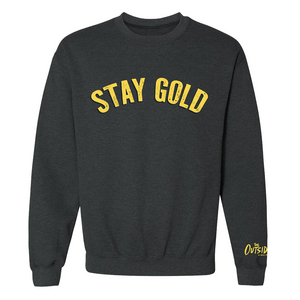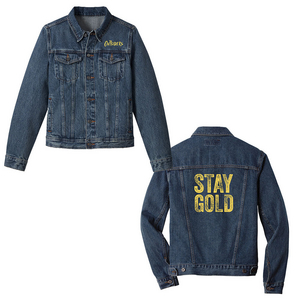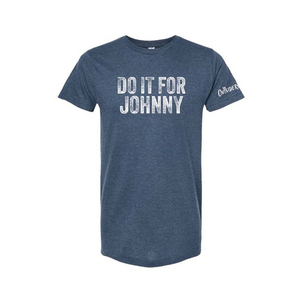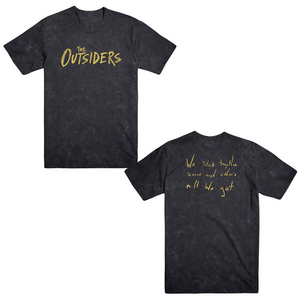Interview: The Kuperman Brothers Discuss the Tony-Nominated Movement of THE OUTSIDERS
The Kuperman brothers talk about creating the movement vocabulary for the new musical, the collaboration process, and much more.

|
|
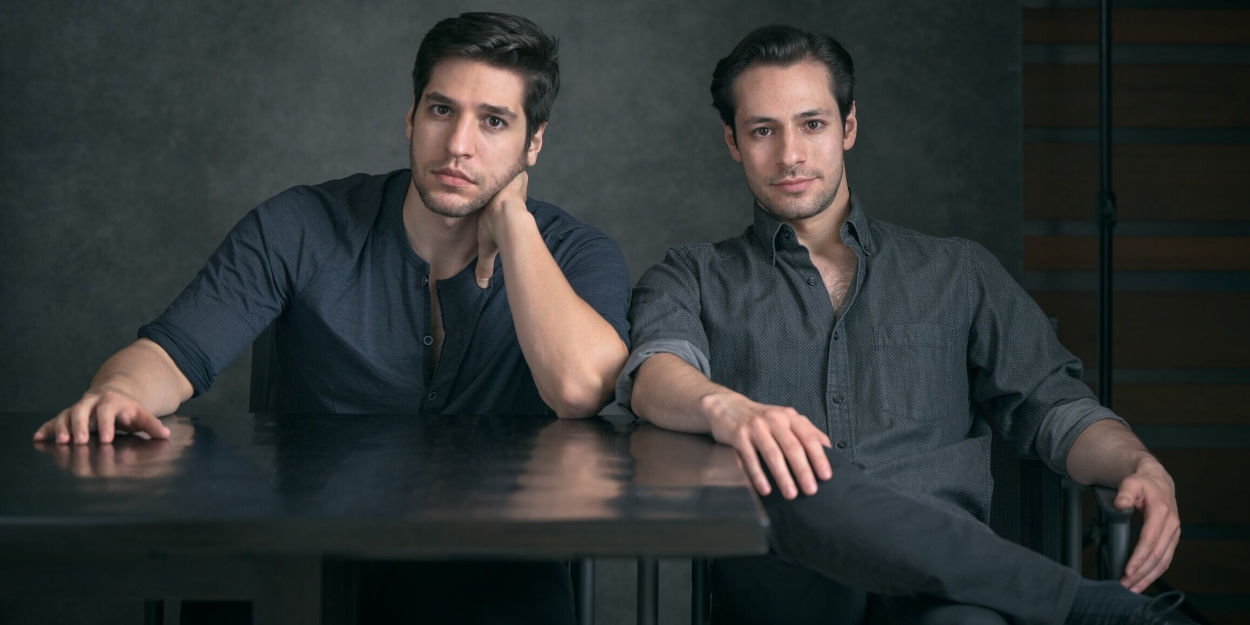
Choreographers The Kuperman Brothers, Rick and Jeff Kuperman, are now Tony Award nominated for their work on The Outsiders on Broadway.
The brothers' resume spans across stage, film, and television, with credits including Netflix’s “Living with Yourself"; Cyrano Off-Broadway starring Peter Dinklage; Phish's Madison Square Garden New Year's Eve show; A24’s movie musical Dicks: The Musical starring Nathan Lane, Megan Mullally, and Megan Thee Stallion; Alice by Heart Off-Broadway, and more.
BroadwayWorld spoke with Rick and Jeff Kuperman about creating the movement vocabulary for the new musical, the collaboration process, and much more.
When did your journey of choreographing together first begin? And for both of you, how is it working with alongside your brother?
Jeff: We grew up in the dance studio together, training since we were about seven or eight years old, all through high school. And then we went off and had our own journeys through college. But, during the summers of college, we would come together and work for a downtown theater company here in New York City doing Off-Off Broadway, very experimental, physical theater, devised works, which we were performing in, and often times would choreograph together. And after college we came together and said, “This seems to be working, let’s see if we can make a go at this.” And after that it unfolded naturally and organically.
Rick: During college, we would be involved in our own student productions, and worked on pieces separately as well, and what we found was that not only was the product better at the end of the day when we were collaborating, but we also had more fun making it. And so, after we had those two realizations we said, “Okay, why don’t we give this a shot together?”
Jeff: We have our shared vocabulary and shared foundation, but we have our own perspectives and own experiences to bring to the table. So, when we combine that it’s a productive collaboration.
What does the choreography process typically look like for you both? Does it fully depend on the medium in which you’re working, or do you have a set process no matter what?
Jeff: It’s a good question, and I think you’re right to ask about medium, because of course the medium you’re working in dictates how choreography plays into the product. So, if you’re choreographing for film, we often start thinking about shot lists, and where the camera is being placed, and how to choreograph the camera in addition to choreographing the dancers and actors in front of the camera.
But, it always starts with reading the script and identifying one or two sequences or numbers that resonate for both of us, and we start by really picking that scene or sequence number apart, getting in the studio and trying out a few ideas, and getting an idea of how to tackle that specific number. And once we unlock that, once we get a sense of the movement vocabulary for that piece, it starts to trickle down throughout the entire script for us to see how we would approach all the other moments. But as long as we have that one starting point, things start to flow pretty organically.
Rick: In the case of The Outsiders, one of the first major sequences that really resonated with us was the rumble that Adam Rapp had written about a full page of exquisite stage directions for. And so, we got into the studio very early in that process and started to figure out a vocabulary for how we might stage the rumble in a Broadway house, which is very different, of course, from how you’d choreograph a rumble for camera, or how you’d do it in an immersive theater setting. The form is the Broadway theater. So, we started to play and unlock some of the vocabulary as Jeff mentioned, and that went and informed not only how we would render violence earlier in The Outsiders in much earlier scenes, but also how sound might play in the show as a whole, and even how it would inform the more general movement idiom of the piece.
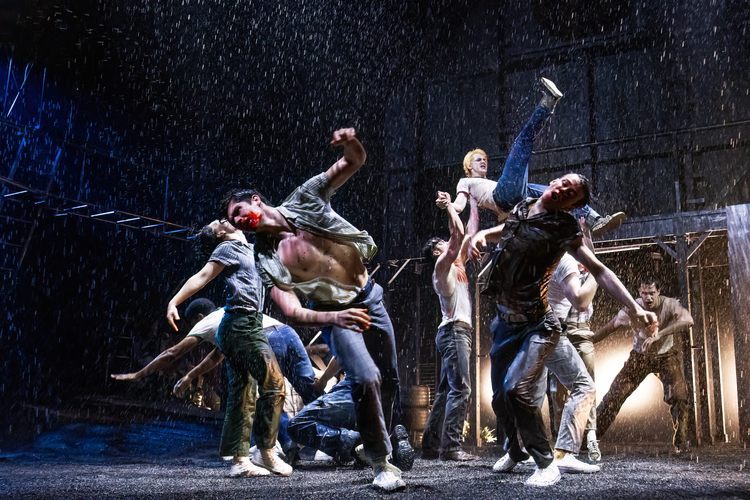
You talk about movement vocabulary; how did you decide where to go stylistically and visually with The Outsiders?
Rick: What’s unique about this project is that the whole creative team has really come together in an extraordinary way, in a way that we’ve never really experienced before on another creative project, where there is a true mind meld. And that is a result of our director Danya Taymor’s amazing leadership on this project. We really started to break the traditional boundaries of the creative team rules, and really became true collaborators all across the board.
But, in terms of crafting the movement vocabulary, one potential trap with The Outsiders is that you have the Greasers and the Socs, you have the red team and the blue team. And so, we were careful not to fall into the cliche of the Greasers have just their own way of moving, and the Socs have their own way of moving, and there is no middle ground between them. Because at the end of the day, they all are teenagers living in Tulsa, 1967, and they all share a public space in the drive-in. So, while, of course, we needed to delineate the two groups, we also wanted to give an unified feeling of movement in the show.
Jeff: Of course, certain musical numbers, it’s quite organic what the movement style will be. In the drive-in we have a lot of social dance, it’s part of the storytelling. But, movement is not just dance, of course, and like Rick said, breaking open the rumble first helped us see a way that the ensemble moves together throughout. And the way that the creative team likes to describe the show is a memory play. The set is a memory playground. And so, moving from memory to real time, to place to place, requires a changing of the set with the ensemble and the actors making those changes. And how to do that organically was a big part of the challenge to figuring out what the movement style would be. That was one of the considerations that were upfront in our brain as we made the show.
Talking about the rumble, it combines dance choreography and fight choreography. How did you approach that, knowing it’s a dance, but it needs to portray violence?
Jeff: As soon as we began working on the rumble, we knew we wanted the rumble to have certain phases. At first, it’s just a melee between these kids pummeling each other, and we wanted to honor the reality of that. So, that’s just a bunch of fight choreography that we worked on with each individual pair of trio, and syncing everyone up so we could choreograph people not stepping on each other’s heads and hands. In the sound design certain thunderclaps cue the actors, ‘Okay, this phase of the fight is done, now you can move onto the second phase’. But we always wanted it to start naturalistically.
Then over time, in some cases without the audience even knowing, it morphs into something that’s more expressionistic, that is more synchronized, and actually is more brutal than the fight choreography itself. Because when you’re executing fight choreography, you’re not fighting an opponent, you’re fighting a partner and collaborating to make the fight look real. And so, you need to make sure that you’re taking care of your partner, and you’re not hurting your partner. But once you divorce the fighting from that aspect, you can embody the violence in a more brutal way.
And speaking about medium, one of the things about film that’s so effective, in terms of violence, is the way we interpret violence on film is aurally, if you see a fight sequence without any foley added, it looks kind of silly. Bxsut once you sync sound and choreography together, the impact is much greater. And so, we borrowed from film in that respect, to really land the brutality of the rumble. When we were first staging it, we would go home and create a violent score, rhythmically, that we would try out the next day, and we pieced it together bit by bit in that way.
Rick: It was important to us, when we first read the script for the musical adaptation of The Outsiders, that to come on board and to choreograph the show would mean not only creating the movement and the dance, but also all of the fight vocabulary so that it felt unified at the end of the day.
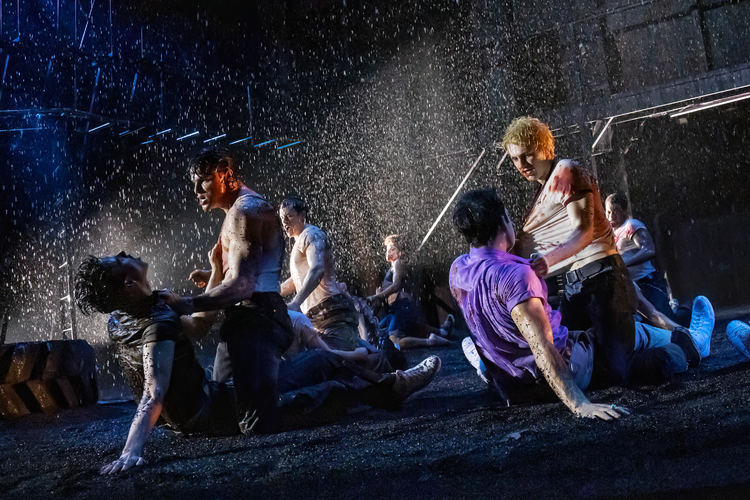
What has it been like working with the company?
Rick: It’s been a blast. These are young, vital, focused, extremely talented young performers, and many of them are making their Broadway debuts and will have long and wonderful careers. But it’s been a pleasure to see that kind of energy and vitality on stage every night.
Jeff: We really leaned into their individuality. Their DNA is all over this show, it’s so ingrained in the fabric of this show. There are some unison moments, there are sometimes when we have to get really into our choreographer mode and clean and clean and clean, but it’s not really a show generally like that. Everyone’s individuality can really shine. And that was important too, because even the ensemble really plays one character throughout, so they were really able to carve out their own track through the show, and that’s what’s so exciting about it.
What do you hope audiences take away from The Outsider?
Rick: I hope they see that some of the challenges and tragedies they’ve faced in their own lives are a part of the human experience, and they are an inevitable part of what it is to be alive. And so, to see how a young boy, Ponyboy, deals with some huge loss so early in his life, but finds the courage to keep going and to brush himself off and keep moving forward, I hope that that’s inspiring for the audience.
Jeff: One of the main messages of the musical, for me, is it questions the way that we can keep our own individuality even as we belong to a chosen family. One of the lines that resonates with me is, Ponyboy at the end of the show says to his brothers, “I love Greasers, and I love being a Greaser, but I ain’t just a Greaser, I got a lot more inside of me than just grease.” Which is to say that even as we make bonds and think like our group, there is always an opportunity to take a step back, and internalize, and reflect on what you think apart from that group as well. And that’s important too.
.png)
|
.png)
|
Videos


